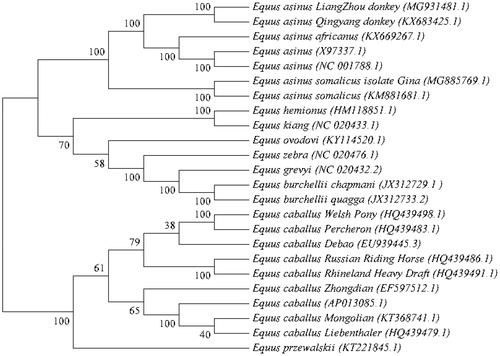Abstract
Liangzhou donkey (Equus asinus) is one of the most important donkey species in China. In this study, we sequenced the complete mitochondrial genome by next-generation sequencing method, the results show it was 16,560 bp in length, consisting 37 genes: 13 protein-coding genes, 2 rRNA genes, 22 tRNA genes, and a non-coding control region. The base composition of the genome was 32.4% for A, 28.7% for C, 13.2% for G, and 25.7% for T; A + T for 58.1%. The phylogenetic analysis demonstrated that Liangzhou donkey was more closely related to Qingyang donkey and processed distinct relationships with other Chinese donkey breeds. This work characterized the mitochondrial genome of Equus asinus (Liangzhou donkey) and presents significant genetic information for this special species.
China has the highest donkey population in the world, mainly distributed in Shanxi, Shandong, Henan, Xinjiang and Gansu province (Ge et al. Citation2007). It can be divided into three types according to the body size: large, medium, and small. Liangzhou donkey belongs to the small body size type, it is also a very important donkey species in China which has high adaptability, good reproduction, mature early, growing quickly, can endure coarse feedstuff and other good characters (Yan Citation2011). It has been listed as a distinctive local variety in The Species of Livestock and Poultry in Gansu Province in 1982. In the past 20 years, the population was reduced sharply because of the development of agriculture and transportations (Lu et al. Citation2008). In 2009, Liangzhou donkey was listed in The Protect List of Livestock and Poultry Genetic Resources in Gansu Province. However, the complete mitogenome sequences of Liangzhou donkey has not been reported yet. In this study, we determined the complete mitochondrial genome sequence of this species. The complete mitogenome of Liangzhou donkey would provide a detailed genetic information for the genetic structure study of this species.
Liangzhou donkey is the oldest primitive breed in Gansu Province, its central production area is located in Liangzhou District of Wuwei City in Hexi Corridor, 101°59′–103°23′E, 37°23′–38°12′ N, with a total area of 33,000 km2, where temperate arid continental climate is found, with a large daily temperature difference. The annual average temperature is 7.8 °C, frost-free period is 85–156 days, annual precipitation 52–522 mm, evaporation 1400–3010 mm, sunshine hours 2200–3030 h. The main crops are wheat, corn, millet, barley, flax, oilseed rape, fruits, and vegetables. The available natural grassland area is 1,380,700 hm2. Liangzhou donkey is very suitable for local conditions.
The blood samples of Liangzhou donkey was obtained from Gulang county Wuwei City (N37°50′02.51′′, E103°23′04.29′′), stored in the Lanzhou Institute of Husbandry and Pharmaceutical Sciences of CAAS at –80 °C, the total genomic DNA was extracted by genomic DNA isolate kit (Tiangen Biotech, Beijing, China) according to the manufacturer’s instructions. Mitochondrial DNA was sequenced using the next-generation sequencing method (Illumina Hiseq X Ten), and the DNA fragments were trimmed by CLC Genomics Workbench v10 (CLC Bio, Aarhus, Denmark) and then assembled using NOVOPlasty v2.6.3 (Dierckxsens et al. Citation2017). The complete mitochondrial DNA was submitted to GenBank with the accession number MG931481.1.
The total length of the mitochondrial DNA is 16,560 bp, with the base composition 32.4% for A, 28.7% for C, 13.2% for G and 25.7% for T; A + T for 58.1%. It contains 13 protein-coding genes (PCGs), 22 transfer RNA genes, 2 ribosomal RNA genes (12S and 16S rRNA), and a noncoding control region (D-loop region). Among these genes, NADH dehydrogenase subunit 6 (ND6) and eight tRNA genes (Gln, Ala, Asn, Cys, Try, Glu, Pro and Ser) are located on the light strand (L-strand), while all the remaining genes are located on the heavy strand (H-strand). The phylogenetic position of Liangzhou donkey was reconstructed based on the PCGs of 24 species using MEGA7.0 software (Kumar et al. Citation2016) with a neighbor-joining (NJ) tree. Bootstrap values were calculated using 1000 replicates to assess the node support. The molecular phylogenetic analysis revealed that Liangzhou donkey has a closer genetic relationship with Qingyang donkey (). The complete mitochondrial genome of Liangzhou donkey will provide essential molecular data for further studies on phylogeny and evolution of donkey, and also important for the breed evaluation, conservation, and utilization.
Disclosure statement
No potential conflict of interest was reported by the authors.
Additional information
Funding
References
- Dierckxsens N, Mardulyn P, Smits G. 2017. NOVOPlasty: de novo assembly of organelle genomes from whole genome data. Nucleic Acids Res. 45:e18.
- Ge QL, Lei CZ, Jiang YQ, Zhang W, Dang RH, Zheng HL, Zhang AL, Li TP. 2007. Mitochondrial DNA D-loop genetic diversity and origin of Chinese domestic donkeys. Acta Vet Zootech Sin. 38:641–645.
- Kumar S, Stecher G, Tamura K. 2016. MEGA7: molecular evolutionary genetics analysis version 7.0 for bigger datasets. Mol Biol Evol. 33:1870–1874.
- Lu CJ, Xie WM, Su R, Ge QL, Chen H, Shen SY, Lei CZ. 2008. African origin of Chinese domestic donkeys. Hereditas (Beijing). 30:324–328.
- Yan BL. 2011. A brief introduction of Liangzhou donkey industry situation. Pratacultural Sci. 28:493–495.

